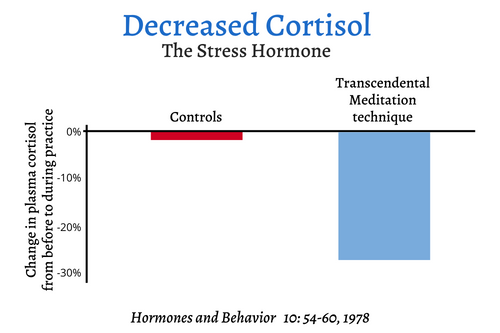Introduction
I had been looking for some new meditation techniques for quite some time. I wanted something completely different from the techniques I already knew, but was struggling to find the one thing that would resonate with me. I had come across this term, Transcendental Meditation (TM), quite a few times in the past years and especially in the past few months but I somewhat refused to take it into consideration. I admit that the term “transcendental” somehow annoyed me. On one hand, I felt like it was somewhat pretentious; on the other hand, it sounded as if it was aiming at separating oneself from reality rather than being a tool to investigate one’s reality and come to terms with it. Too often meditation techniques are mis-used as an escape route, a way to distance oneself from the issues that are too painful to look at. On the contrary, meditating helps us reach depths that are otherwise unfathomable by our conscious mind, and can gradually open our consciousness to realities that have been long overlooked or forgotten.
So, although being sceptical at first, I was soon to discover I was wrong (with great delight). Transcendental Meditation kept cropping up everywhere I looked—even when I was not looking—so I decided to do some proper research and, eventually, resolved to register on a course.
In this article I share with you what I learnt about TM and my experience with it to date.
What is TM and How it Works
TM is a form of silent mantra meditation, developed and divulged by Maharishi Mahesh Yogi in the mid-1950s, practised for 15–20 minutes twice per day. In short, all you have to do during the meditation is repeat the mantra, which the teacher gives you, silently in your mind while seated with your eyes closed. Easy peasy.
The general benefits of TM are very similar to any other form of meditation: reduces stress, decreases anxiety and depression, promotes better sleep, and strengthens the so called executive functions, i.e. purposeful thinking and farsighted decision-making.
Like most meditations, TM does not involve or require any form of belief, religious and non. You could well be very sceptical and yet you’d experience the results.
As my investigation went on, and I attended two different introduction calls, I learnt that during TM your body gains a level of rest and relaxation that is deeper than the deepest part of deep sleep, so much so that research shows that after 20 minutes of practising TM, cortisol levels drop around 30%. Quite impressive.

In terms of the technique itself, there is a fundamental difference between TM and other practices, a characteristic that separates it from any other technique: the (almost) complete disengagement of Mind. TM requires no association, no visualisation, no focus of attention (on the breathing or the body). It works with the assumption that a state of complete rest “allows your conscious mind to gain familiarity with deeper levels of the mind, bringing the subconscious mind within the capacity of the conscious mind”.
Moreover, since you need no special concentration, so long as you keep your eyes closed and can sit down, you can do it literally anywhere.
The ocean analogy
During the course, the teacher uses the metaphor of the ocean to describe the mind. The water on the surface can be more or less agitated; as we move in/downwards the mind becomes quieter and calmer, until it reaches a place of complete stillness—a state that many call the Absolute or the Cosmic Mind.
The surface is where all conscious activities take place, i.e. the constant rumbling of our minds busy with thoughts, plans, worries, deadlines, responsibilities, etc..
Right below the superficial level of activity, there is a portion of the mind where it is quieter, and one feels calmer. This level is a state that most meditations allow you to experience. However, the teacher goes on, at this level the mind still plays its role: most meditation techniques instruct you to visualise, use your imagination, focus on your breathing or parts of your body, some even encourage you to actively block your thoughts. These are all things that maintain some level of mental activity and can, at times, create a level of frustration that disturbs the ocean (in other words, disturbs the peace of mind).
TM supporters affirm that while other meditation techniques allow you to experience the level immediately below the active surface, this practice takes you further down the levels of your mind into a state that leads you closer and closer to the bottom, where the subconscious mind meets the cosmic mind. In this state of complete rest “one can experience the ‘source of thought’, which is said to be pure silence, pure awareness”.
The Course
The course requires minimum effort and is time efficient. It splits over 4 days, when you meet in person with the teacher and then the rest of the group for 1-2 hours per day.
Day one is a 121 session where the teacher interviews you, and together you discuss your current situation, some of your issues, your personality, your health, and what you want to achieve. These details give the teacher enough information to assign you your mantra.
On the first day, you are also requested to bring a handful of rice, 3 pieces of fruit and 4 roses (or other types of flower). Alternatively, you can pay £5 and those items are provided.
Those items are used during a ceremony that takes place after the interview in front of a little altar with a photo of Maharishi Mahesh Yogi, while you are simply asked to witness it.
At the end of the ceremony, the teacher gives you your mantra. At first, you repeat it out loud with them, gradually softening your voice until you repeat it only in your mind. You do this with the teacher for about 5 minutes in front of the little altar where the ceremony took place. Then you both sit down and meditate together for 5 more minutes. After that, it is Q&A time and then you can leave.
The other 3 days are group sessions of about 2 hours each. During these meetings, the teacher tells you more about what you can experience during meditation and how to practise TM correctly. You also watch some original footage of Maharishi running public sessions, speaking about TM and its practice, and sharing interesting insights.
I am not going to describe each day in detail as I think it is fair to let people experience it for themselves and with an unconditioned mind. The one part I will mention, though, is the most interesting concept of inward stroke and outward stroke.
Inward Stroke and Outward Stroke
This is something that happens to our mind quite frequently, particularly of course when we meditate using any type of technique. Maharishi explains it directly in an article on the foundation website (see resources below).
From my understanding and in my own words, the inward stroke is the tendency of the mind to reunite with its own true nature, one of stillness and silence. It is a direction that the mind follows naturally during meditation. The true nature of Mind can be perceived every time we experience that deep silence within ourselves. At the beginning, that silence lasts but a few seconds, but with time we can experience longer periods of silence that also becomes more intense.
Oftentimes it happens that the silence is interrupted by thoughts, sometimes random thoughts or chains of thoughts, that disturb that stillness. This is the outward stroke, which is the body’s natural tendency to release tensions. As the mind travels down towards that pure awareness, the relaxation produced by the inward stroke allows for some forms of tension to be released. The release of that tension pops out as memories or thoughts. So thoughts or memories, no matter how random they may seem, are an expression of the subconscious releasing the source of tension, and a manifestation of deeper levels of consciousness being reached.
This concept revolutionises the whole perception of thoughts during meditation, replacing the frustration with higher awareness and gratitude. In fact, although you don’t actively entertain the thoughts (if not for a short period of time, while you keep repeating the mantra), you now understand that those are, in fact, an indication of a deeper state of relaxation.
The analogy that I can offer is this: imagine your hand closed in a tight fist (representing tension) and inside it there is a butterfly (representing a thought, a worry). What happens during TM is that, as you repeat the mantra, your hand (representing your mind) gradually relaxes to the point where it is so relaxed that it opens fully and the butterfly flies away. This releases the thought, or worry, from the subconscious into the conscious mind and simultaneously enables you to reach an even deeper level of consciousness. Each thought that is released corresponds to a deeper level, and so on. How brilliant is that?!

My Personal Experience
I have practised TM only for about two month now, so I am at the very early stages of the practice. Since the first day of training, I have been impressed by how deep and effective this technique is despite being easy and effortless. There is no challenge for the meditator: you sit down, close your eyes and repeat the mantra.
Usually the first few minutes (up to 10 minutes depending on the day), I experience a phase of settling down of my emotions and body tensions, with lots of thoughts popping up that help me gain awareness of how I really feel and what is really on my mind. I have a tendency to push away things that I consider unworthy of my time and attention and can be quite good at ignoring their presence. However, by doing so I run the risk of overlooking or underestimating their impact and can end up paying the consequences later (in the form of stomach aches and anxiety). So, if you are anything like me, TM helps you connect with yourself and maintain awareness.
After that initial phase, it is as if I walk past a threshold and repeating the mantra takes me to a silent space within myself. At first, I am able to linger in that space only for a few seconds, but the more I practise the longer those moments last.
Past that threshold, what happens changes every time. Sometimes my thoughts keep me company right to the end with a few pauses between them. Less often, it is as if I am visiting other places or I overhear entire conversations between people. I don’t always recognise where I am or the people but it is extremely realistic as if I were there in the flesh. Some other times, I seem to be meeting with my inner child (me at the age of 4-5), and having wordless conversations with her. It is an internal dialogue that takes place silently—I know what she is telling me.
On other occasions, I have had dream—like experiences although I am not asleep and fully aware. There are also times where the experience is less eventful, if you like, and I feel peace, silence and a sense of bliss.
Every session is different and, as Maharishi says, it is important that you “take it as it comes”.
Regardless of what has happened during the meditation, everytime I finish my 20 minutes, I feel profoundly relaxed, my mind is much quieter and my emotions more stable. I have the feeling that my body moves more harmoniously, almost as if I were lighter, and my face looks softened, like after a long night of good sleep. Overall, my body is more relaxed (I was impressed that I no longer need my retainer, which I use as I have a tendency to grind my teeth—sign of deep rooted tensions). Generally, my mind is clear, my mood is either positive or neutral, I feel more open towards people, and my ability to communicate is enhanced—I can express how I feel or what I think more exhaustively and clearly without any effort. I also seem to find solutions, for myself and others, that I had not considered before—sometimes during the meditation I feel a strong impulse to do something specific once the session is over. Of course, I obsequiously do it, and it does turn out to be the right thing to do. Very interesting indeed.
I am very happy with this meditation technique and I am very curious about what’s to come.
Conclusions
Transcendental meditation is the easiest technique that I know of out there. It is not challenging or demanding, you can do it anywhere, its benefits are experienced since day one and they grow daily. It does not require effort to reach the deeper levels of the mind.
It is important to say that other techniques also allow you to reach the Absolute with the difference that they might require more time and/or effort.
At the same time, other techniques that I have practised have provided me with practical tools for self-knowledge helping me understand how I (and human beings in general) function. Those, so to say, “active” techniques have stimulated my mind and helped me push the boundaries of what I thought I was capable of or just possible. Techniques like Silva Mind Control, for example, have been instrumental to my self-discovery and self-healing. And also given me the chance to make a difference in someone else’s life.
This practical, proactive side seems to be lacking in TM.
Ultimately, if my niece were to ask me for advice on the topic of meditation, I’d tell her to learn one or two “active” meditation techniques, and learn about breathing, mind control, mind dynamics and, why not, some basic NLP techniques, because those techniques help you gain precious tools for self knowledge and for taking your life in your own hands.
I would then suggest that she also try TM as it enables you to access deep states of consciousness in a different way than other techniques.
A few steps further down the experience with meditation, one could also decide to try spiritual technologies (like HemiSync®) that allow you to explore the complexity of our reality beyond the visible.
In conclusion, there is no right or wrong, and there is no one technique better than another one. It all comes down to which technique suits you best, what resonates with you according to what you want to achieve, your preferences, how you learn, your current needs and what effort you can or are willing to put in. You are where it all begins and ends. You are what matters. Certainly, not the latest trend in meditation, nor the opinion of others. So start with a sincere, non-judgemental acknowledgment of the above. And then go with what feels right for you, you somehow already know what’s best for you. Listen.
I hope that you find this article useful. Look out for future articles on this and many other topics in the area of energy, meditation, self-discovery and consciousness awakening.
In the meantime, should you have any questions or like to hear about a specific topic, feel free to reach out to me.
Useful Resources
Please see these links for more info about what’s been discussed in this article
- TM website in the UK – Transcendental Meditation. TM is taught all over the world so you can find the foundation local to you
- Outward stroke and inward stroke – Human Suffering and Stress: How can Transcendental Meditation Help?
- ABOUT HEMI-SYNC® – Monroe Institute UK







